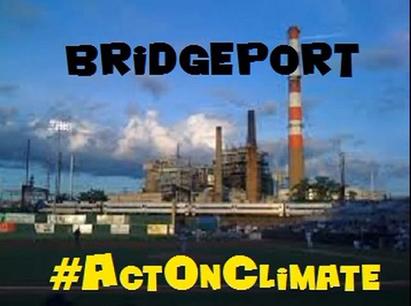
A coalition of environmentalists will conduct a rally on Saturday from 4-6 p.m. at Baldwin Plaza Downtown to urge the closing of the coal-burning plant in the South End. A new website has been launched in conjunction with the rally. See here.
News release from organizers:
On Saturday, September 13, climate justice, environmental and peace groups will hold a rally for climate solutions at Baldwin Plaza. Local residents will be calling for the retirement of the Bridgeport coal burning plant, guaranteed jobs for displaced workers, an end to oil wars and war preparations that increase climate pollution and for a massive turnout at the upcoming People’s Climate March in New York the following week.
“Dirty coal plants are dumping their exhausts into our air and the results are that our children and our elderly and others suffering from the soot and mercury and arsenic. They have to take all those breathing treatments from pumps and steroids and such just to be able to breathe fresh air. The existing coal fired power plants are also the single largest carbon pollution source in our state and that’s helping to change the climate for the worse,” said Elaine Ward of the CT Coalition for Environmental Justice.
“Bridgeport families are sick of pollution from coal that threatens our air, water and climate. We want Connecticut to be a leader in tackling climate disruption and building a clean, renewable energy economy,” said Onté Johnson, Sierra Club Bridgeport Organizer.
“We can no longer afford the luxury of war. The biggest greenhouse gas producers are the Pentagon and the world’s other militaries. ‘Green’ military vehicles just won’t cut it. The climate movement has to be an anti-war movement,” said Stanley Heller, Secretary of Promoting Enduring Peace.
“If we want a cleaner, healthier, brighter future, we have to make a more serious commitment to investing in clean energy sources and getting rid of polluting sources in neighborhoods that are already economically and environmentally vulnerable. The Peoples Climate March is about making that call to action more visible than it is have ever been in history,” said Jameelah Muhammad, Regional Organizer for 350.org and the People’s Climate March
Sponsors: CT Coalition for Environmental Justice, Sierra Club (CT), Bridgeport Education Association, Promoting Enduring Peace, Middle East Crisis Committee, Environmental Headlines, JVP-New Haven, Fight the Hike, 350.org, International Socialist Organization-CT
Rain date: Monday Sept 15, from 4 to 6 p.m.


The anti-war radicals had better go to Syria and tell ISIS to stop fighting and stop killing people for no reason. There is talk of converting this plant to gas or are these people against gas also?
Some people on this blog can run this plant 24/7 just with the gas they emit!
Coal plants are the nation’s top source of carbon dioxide (CO2) emissions, the primary cause of global warming. In 2011, utility coal plants in the United States emitted a total of 1.7 billion tons of CO2. A typical coal plant generates 3.5 million tons of CO2 per year.
Burning coal is also a leading cause of smog, acid rain, and toxic air pollution. Some emissions can be significantly reduced with readily available pollution controls, but most U.S. coal plants have not installed these technologies.
Sulfur dioxide (SO2): Coal plants are the United States’ leading source of SO2 pollution, which takes a major toll on public health, including by contributing to the formation of small acidic particulates that can penetrate into human lungs and be absorbed by the bloodstream. SO2 also causes acid rain, which damages crops, forests, and soils, and acidifies lakes and streams. A typical uncontrolled coal plant emits 14,100 tons of SO2 per year. A typical coal plant with emissions controls, including flue gas desulfurization (smokestack scrubbers), emits 7,000 tons of SO2 per year.
Nitrogen oxides (NOx): NOx pollution causes ground level ozone, or smog, which can burn lung tissue, exacerbate asthma, and make people more susceptible to chronic respiratory diseases. A typical uncontrolled coal plant emits 10,300 tons of NOx per year. A typical coal plant with emissions controls, including selective catalytic reduction technology, emits 3,300 tons of NOx per year.
Particulate matter: Particulate matter (also referred to as soot or fly ash) can cause chronic bronchitis, aggravated asthma, and premature death, as well as haze obstructing visibility. A typical uncontrolled plan emits 500 tons of small airborne particles each year. Baghouses installed inside coal plant smokestacks can capture as much as 99 percent of the particulates.
Mercury: Coal plants are responsible for more than half of the U.S. human-caused emissions of mercury, a toxic heavy metal that causes brain damage and heart problems. Just 1/70th of a teaspoon of mercury deposited on a 25-acre lake can make the fish unsafe to eat. A typical uncontrolled coal plants emits approximately 170 pounds of mercury each year. Activated carbon injection technology can reduce mercury emissions by up to 90 percent when combined with baghouses. ACI technology is currently found on just 8 percent of the U.S. coal fleet.
Other harmful pollutants emitted annually from a typical, uncontrolled coal plant include approximately:
114 pounds of lead, 4 pounds of cadmium, other toxic heavy metals, and trace amounts of uranium. Baghouses can reduce heavy metal emissions by up to 90 percent3.
720 tons of carbon monoxide, which causes headaches and places additional stress on people with heart disease.
220 tons of hydrocarbons, volatile organic compounds (VOC), which form ozone.
225 pounds of arsenic, which will cause cancer in one out of 100 people who drink water containing 50 parts per billion.
Where did you plagiarize this article from?
Don’t forget, they are one of the largest taxpayers in Bridgeport. Be careful what you wish for.
Yes, please get rid of it. We look like Newark with that albatross.
The coal plant owners are big contributors to Finch’s re-election campaign. They stay, and no one is to question anything they do. PERIOD!